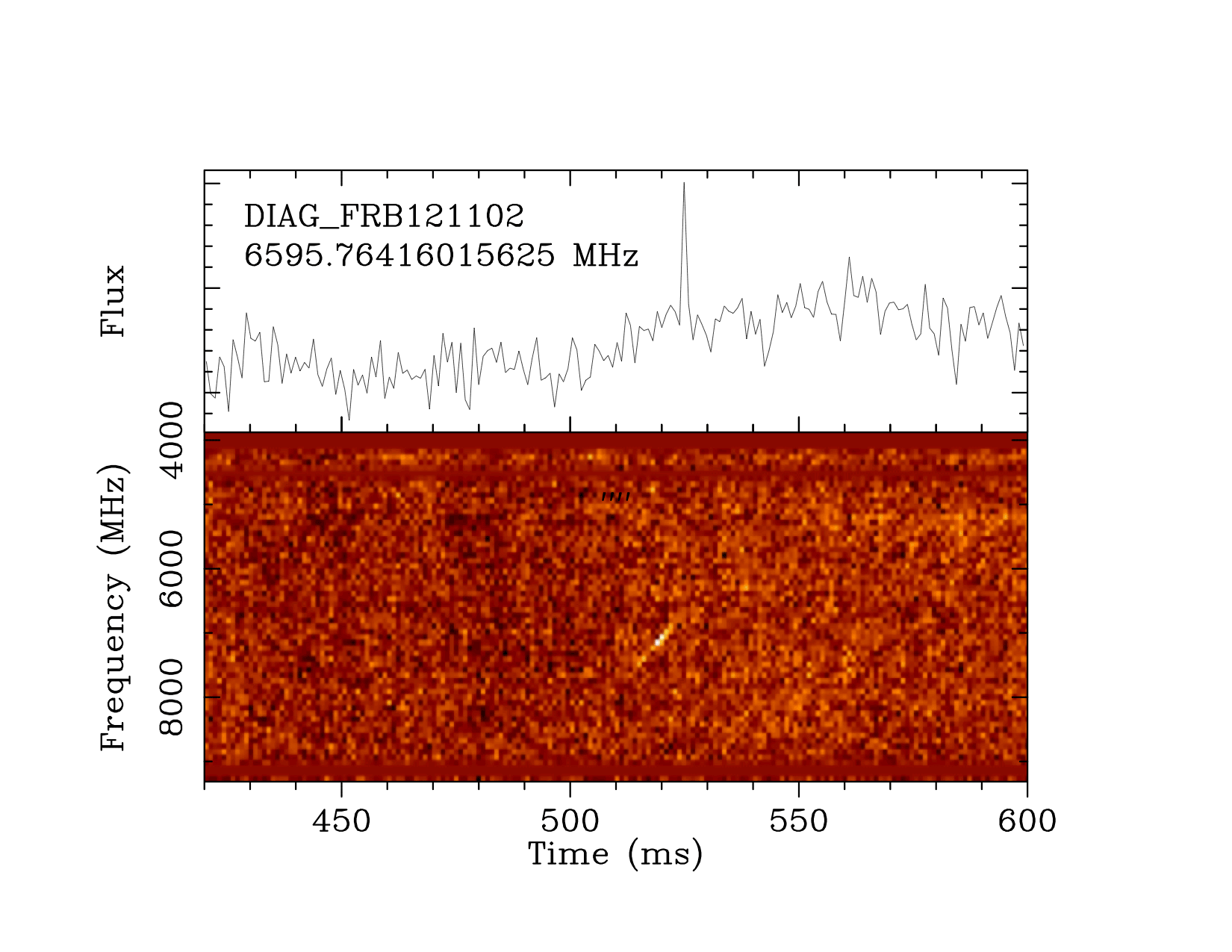Detection of FRB 121102 at C-band using BL@GBT
On Saturday, August 26 at 13:51:44 UTC we initiated observations of the well-known repeating fast radio burst FRB 121102 [Spitler et al., Nature, 531, 7593 202-205, 2016] using the Breakthrough Listen Digital Backend with the C-band receiver at the Green Bank Telescope. We recorded baseband voltage data across 5.4375 GHz of bandwidth, completely covering the C-band receiver's nominal 4-8 GHz band [MacMahon et al. arXiv:1707.06024v2]. Observations were conducted over ten 30-minute scans, as detailed in Table 1.
Immediately after observations, the baseband data were reduced to form high time resolution (300 us integration) Stokes-I products using a GPU-accelerated spectroscopy suite. These reduced products were searched for dispersed pulses consistent with the known dispersion measure of FRB 121102 (557 pc cm^-3); baseband voltage data were preserved.
We detected 15 bursts above our detection threshold of 10 sigma in the first two 30-minute scans, denoted 11A-L and 12A-B in Table 2. In Table 2, we include the detection signal-to-noise ratio (SNR) of each burst, along with a very rough estimate of pulse energy density assuming a 12 Jy system equivalent flux density, 300 us pulse width, and uniform 3800 MHz bandwidth.

We note the following phenomenological properties of the detected bursts:
-
Bursts show marked changes in spectral extent, with characteristic spectral structure in the 100 MHz - 1 GHz range.
-
Several bursts appear to peak in brightness at frequencies above 6 GHz.
Table 1:
Scan No. | MJD | Duration (min) | No. Bursts detected
-----------------------------------------------------------------------
11 | 57991.5776 | 30 | 12
12 | 57991.5986 | 30 | 3
13 | 57991.6196 | 30 | 0
14 | 57991.6406 | 30 | 0
15 | 57991.6616 | 30 | 0
16 | 57991.6825 | 30 | 0
17 | 57991.7035 | 30 | 0
18 | 57991.7245 | 30 | 0
19 | 57991.7454 | 30 | 0
20 | 57991.7664 | 20 | 0
Table 2:
Burst | SNR* | Energy Density | Time* | Sample
| | (Jy us) | (s) |
-------------------------------------------------------------
11G | 60.6 | 144.5 | 597.612 | 1709782
11A | 47.9 | 114.2 | 16.2505 | 46493
11C | 47.2 | 112.5 | 323.352 | 925118
11D | 25.6 | 61.0 | 344.768 | 986388
11E | 24.6 | 58.7 | 356.033 | 1018619
11F | 21.2 | 50.5 | 356.034 | 1018620
11L | 20.8 | 49.6 | 1454.55 | 4161497
12B | 20.7 | 49.4 | 743.071 | 2125942
12A | 13.6 | 32.4 | 104.922 | 300184
11J | 12.3 | 29.3 | 1036.42 | 2965234
11I | 11.6 | 27.7 | 769.864 | 2202599
11K | 11.1 | 26.5 | 1142.41 | 3268458
12C | 10.8 | 25.7 | 1526.39 | 4367026
11H | 10.6 | 25.3 | 691.83 | 1979341
11B | 10.4 | 24.8 | 285.436 | 816640
* seconds from tstart = MJD 57991.5776
These are the highest frequency and widest bandwidth detections of bursts from FRB 121102 obtained to-date. Additional fully calibrated full-Stokes analysis employing coherent dedispersion on raw voltage data is ongoing.
These observations may indicate FRB 121102 is currently in a heightened activity state [Law et al. arXiv:1705.07553], and follow-on observations are encouraged, particularly at higher radio frequencies.
Supplementary materials
This directory contains six of the brightest bursts we detected from FRB121102.
If you are planning on using this data for your publication,
we kindly request you to reference the above mentioned ATel.
For any query, please contact me at < vishalg@berkeley.edu >
